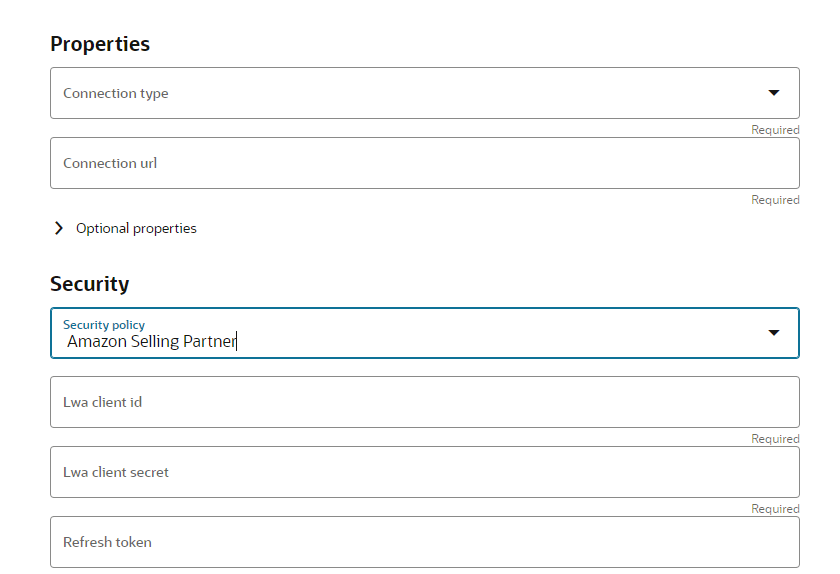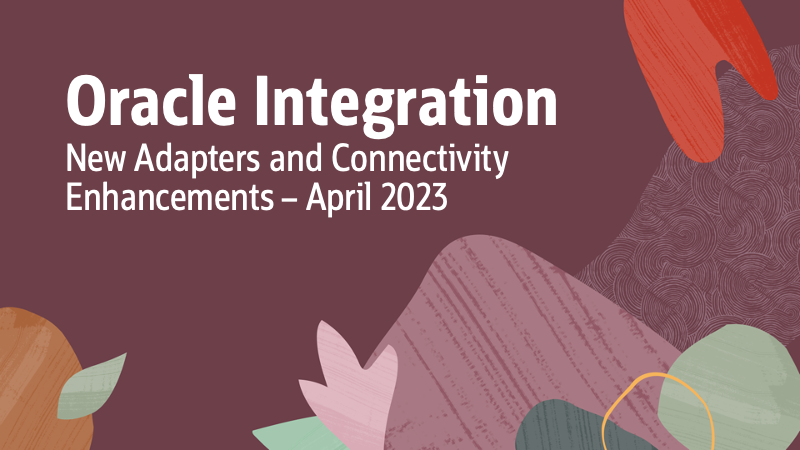
It's time for the Oracle Integration April 2023 update. In this release, we are introducing new adapters for OData and Oracle Primavera Unifier, along with other functional and security enhancements in the existing adapters:
- New Adapter – OData
- New Adapter – Primavera Unifier
- PostgreSQL Adapter – Trigger (Polling) and Running SQL Statement Support
- Netezza Adapter – Trigger (Polling) and Invoke a Stored Procedure Support
- ServiceNow Adapter – Enhanced with Authorization Code Credentials Security Policy
- SAP S/4HANA Cloud Adapter – Client Certificate-Based Security Policy Support
- REST Adapter – Amazon Selling Partner Security Policy
New Adapter – OData
The OData (Open Data Protocol) Adapter is introduced as a new addition in the Technology segment of adapters in Oracle Integration. This adapter enables users to integrate with any cloud application that exposes OData APIs.
In this release, the OData Adapter supports outbound invoke connections with the following capabilities:
- Consumes OData V2 endpoints, and JSON message payload
- Performs Create, Update, Delete, Get, Query, and Replace operations on the selected entity.
- Protects ODATA APIs using OAuth Client Credentials, OAuth Authorization Code Credentials, and Basic authentication.
Note that only OData V2 is currently supported by the adapter. The ability to provide support for Inbound (trigger), Connectivity Agent, Atom XML message format, and OData v4 is on the future roadmap.
The OData Adapter connection needs an OData service root URL and OData version for establishing the connection with a cloud application. In addition, the following security policies are supported by the OData Adapter:
- Basic Authentication
- OAuth Client Credentials
- OAuth Authorization Code Credentials
- No Security Policy
A user can select No Security Policy to create a connection without configuring a security policy. To configure the OAuth Client Credential or OAuth Authorization Code Credentials security policy, a user must register a client application to provide the necessary information on the Connections page. For more information, see the OData Adapter documentation.
Connections page

Let’s now look at how the adapter can be configured. The configuration of the invoke endpoint can be done graphically by selecting the options in the Adapter Endpoint Configuration Wizard.
Select the type of operation to perform on the Operations page:
- Create
- Update
- Delete
- Get
- Query
- Replace
Operations page
(Displayed when Query Operation is selected)
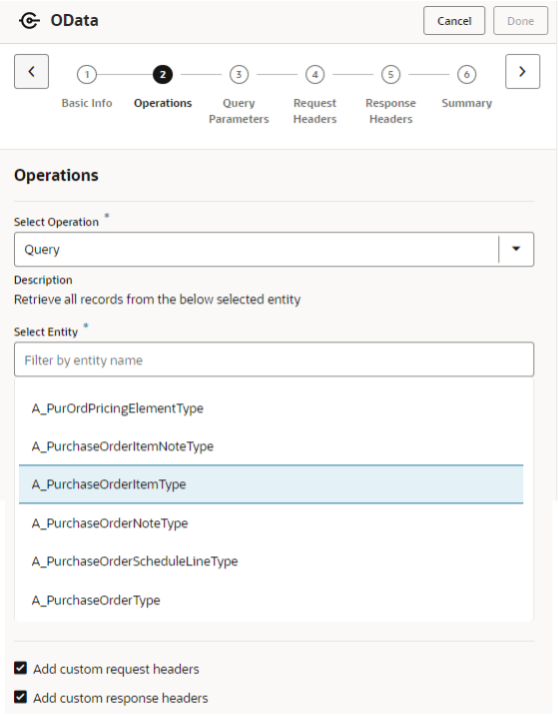
Invoke Query Parameters page
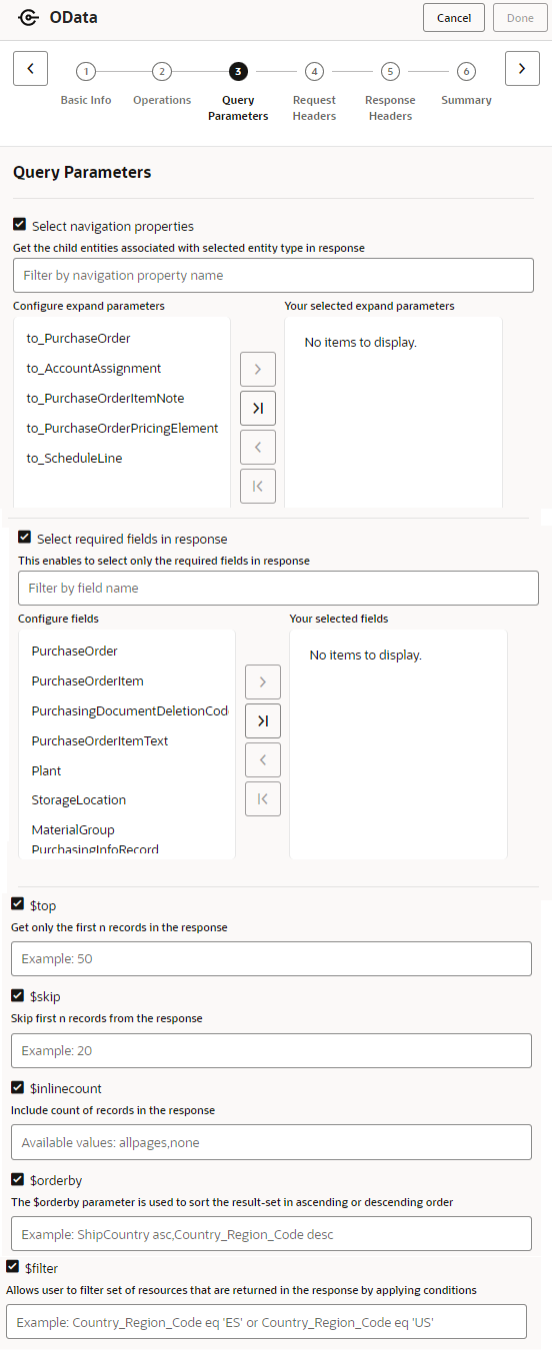
Request Headers page
(Displayed if the Add Custom Request Headers checkbox is selected on the Operations page)

Response Headers page
(Displayed if the Add Custom Response Headers checkbox is selected on the Operations page)

Summary page
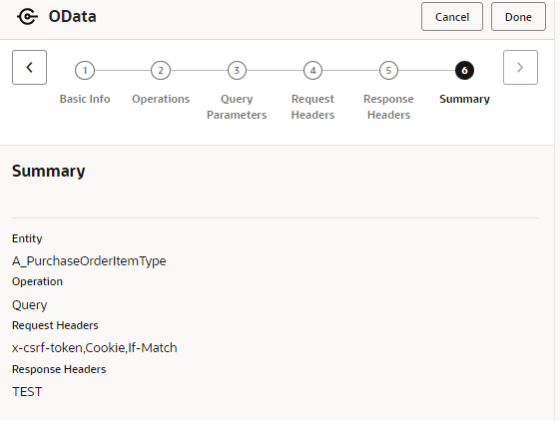
New Adapter – Primavera Unifier
The Primavera Unifier Adapter is a new addition to the Industries group of adapters.
You can use the Primavera Unifier Adapter to fetch, create, or update a Business Process (BP) record (without attachments) in Unifier. It provides for an easy selection of the BP needed for integration. Based on the BP you selected, the fields defined in the integration interface of that BP are available for mappings.
The Primavera Unifier Adapter provides trigger (inbound) and invoke (outbound) support. As a trigger, the adapter enables you to send the BP record data to Oracle Integration for further processing. As an invoke, the adapter enables you to create, update, and fetch records from and into Unifier.
For more information see the Primavera Unifier Adapter documentation.
PostgreSQL Adapter – Trigger (Polling) and Running SQL Statement Support
The PostgreSQL Adapter extends capabilities to support trigger (polling) new and updated records for processing in the PostgreSQL database and execution of SQL queries against database tables. Distributed polling provides high availability and improves performance, which is supported by the adapter. The PostgreSQL Adapter also provides support for a logical delete polling strategy. This strategy involves updating a special field on each row once it is processed.
As a prerequisite, an agent group configuration is required for accessing the service hosted on the premises behind the firewall. To configure an agent group, download and install the on-premises connectivity agent. See Download and Run the Connectivity Agent Installer and About Connectivity Agents and Integrations Between On-Premises Applications and Oracle Integration in Using Integrations in Oracle Integration.
The configuration of trigger endpoint can be done graphically by selecting the options in the Adapter Endpoint Configuration Wizard, similar to other DB adapters.
1. Specify a name on the Basic Info page.
Trigger Basic Info page
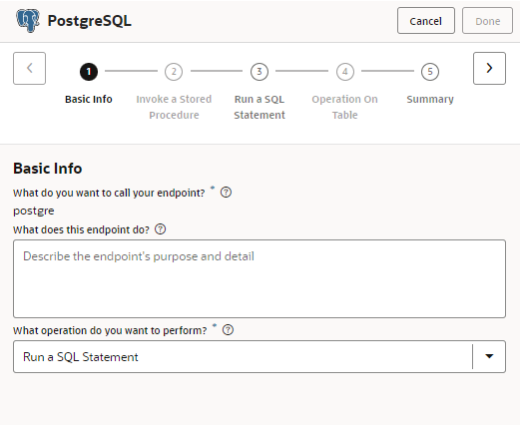
2. Select the table and specify polling options.
Trigger (Polling) page
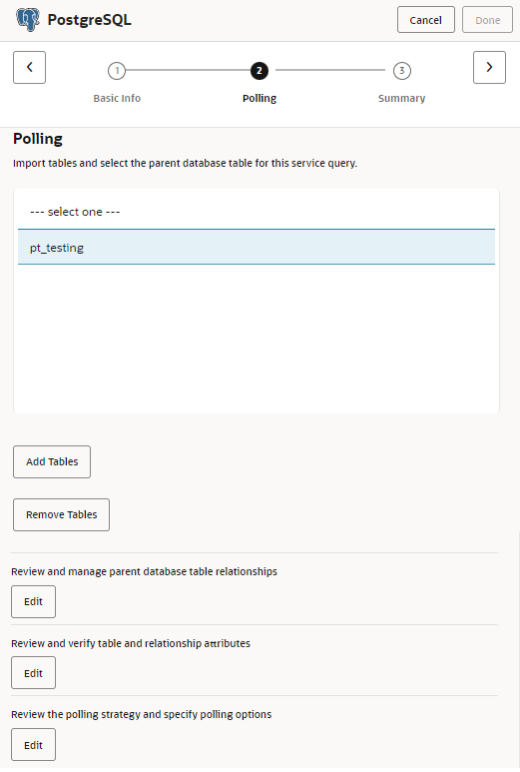
Polling Strategy and Options page
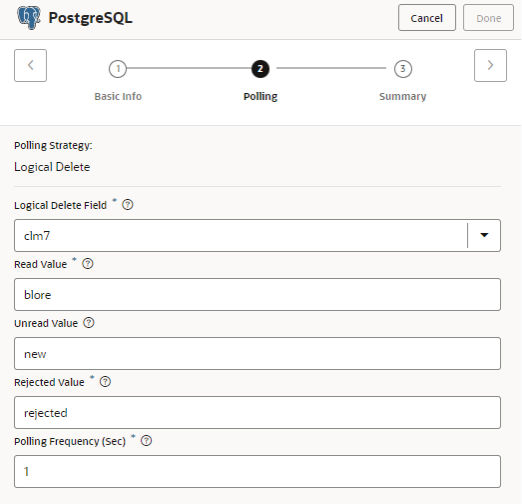
3. Review the specified adapter configuration values on the Summary page.
Summary page
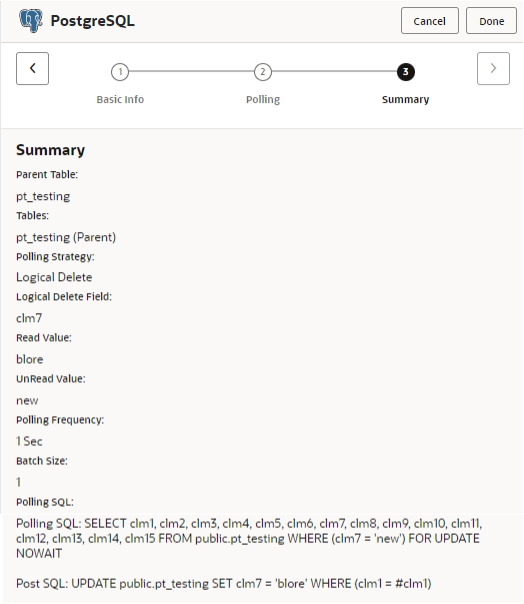
To execute simple SQL queries, select Run a SQL Statement on the Invoke Basic Info page:
1. Select the Run a SQL Statement operation on the Basic Info page.
Invoke Basic Info page
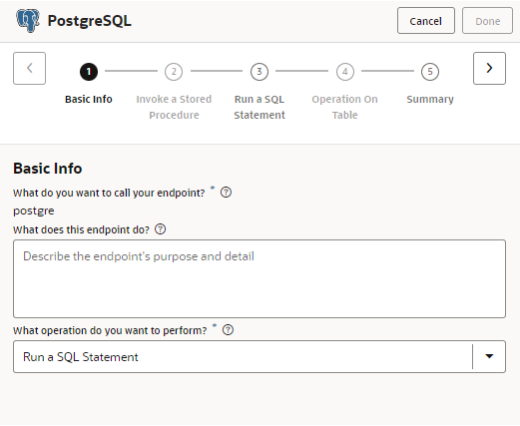
2. Enter a SQL query.
Invoke Run a SQL Statement
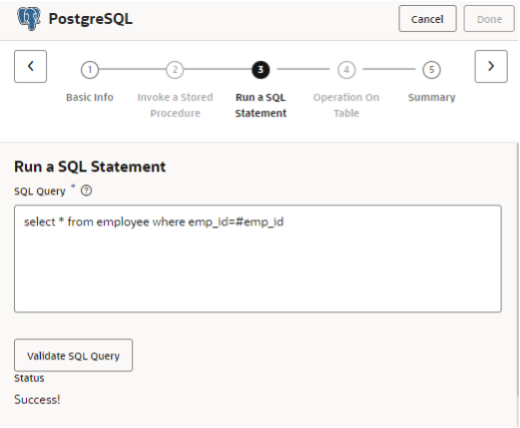
3. Review the specified adapter configuration values on the Summary page.
Summary page
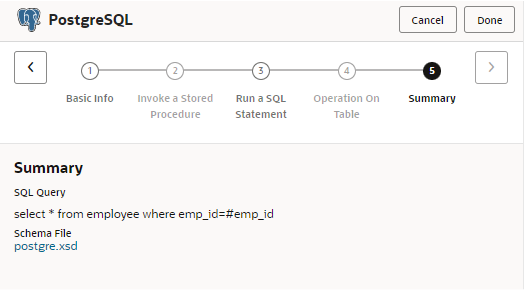
Netezza Adapter – Trigger (Polling) and Invoke a Stored Procedure Support
The Netezza Adapter extends capabilities to support for trigger (polling) new and updated records for processing in the Netezza database and the invocation of stored procedures in the Netezza database. The Netezza adapter also provides support for a logical delete polling strategy. This strategy involves updating a special field on each row once it is processed.
For complex SQL queries, stored procedures can be used by selecting the Invoke a Stored Procedure option on the Basic Info page of the Adapter Endpoint Configuration Wizard. Stored procedures can reduce the complexity of a SQL query.
The configuration of trigger endpoint can be done graphically by selecting the options as prompted by the adapter through the wizard interface. So, let's start with a quick tour of the new wizard interface.
1. Specify a name on the Basic Info page.
Trigger Basic Info page

2. Select the table and specify polling options.
Trigger (Polling) page
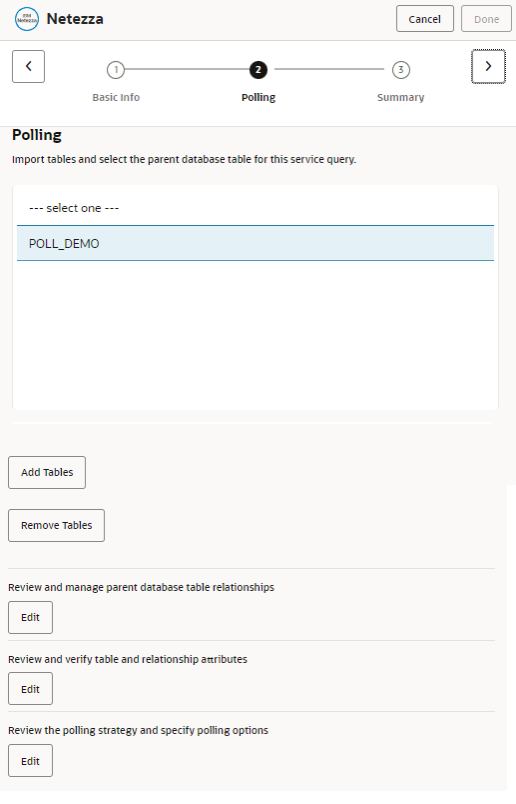
Polling Strategy and Options page
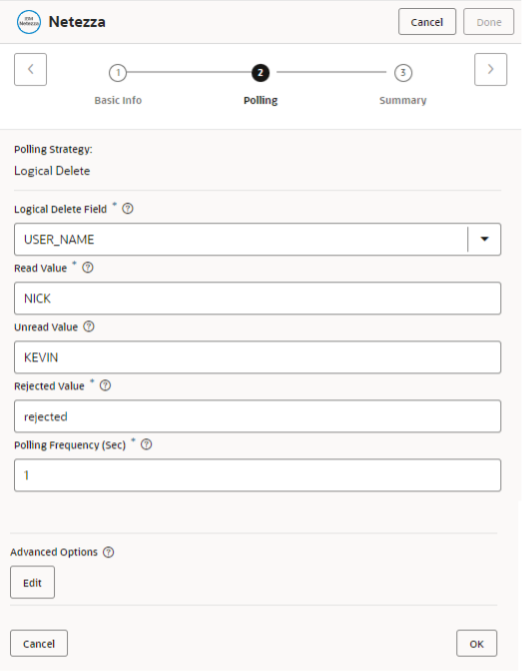
3. Review the specified adapter configuration values on the Summary page.
Summary page
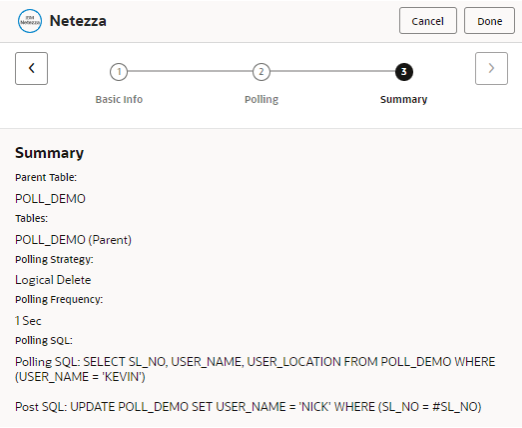
To perform an invoke stored procedure operation, select Invoke a Stored Procedure on the Basic Info page:
Invoke Basic Info page

Invoke a Stored Procedure page
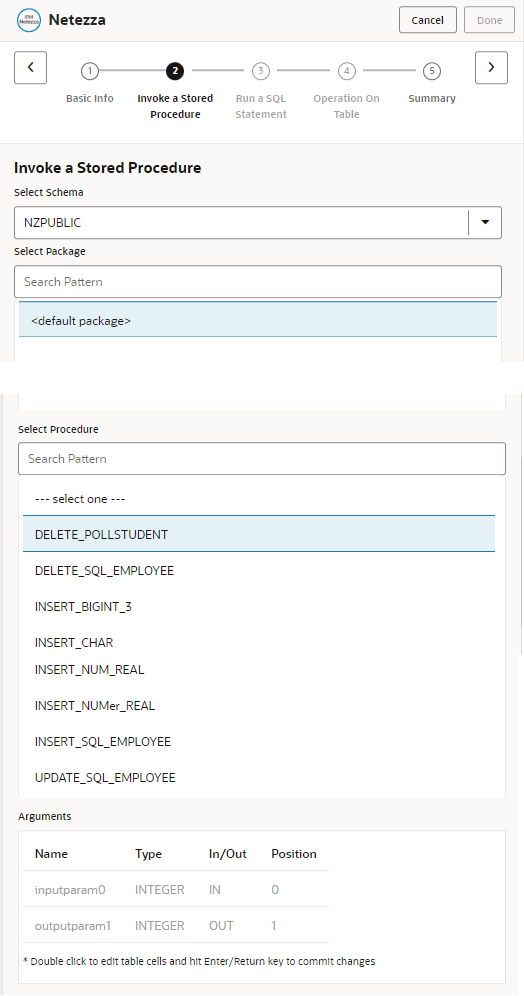
Summary page
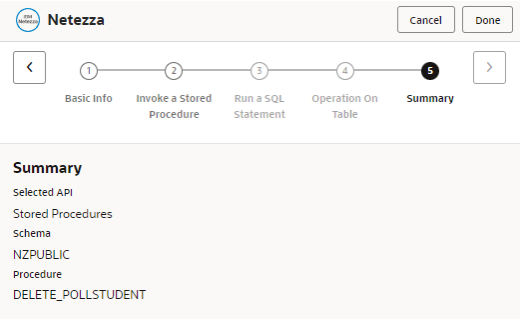
ServiceNow Adapter – Enhanced with Authorization Code Credentials Security Policy
A new security policy “Authorization Code Credentials” is introduced in the ServiceNow Adapter.
Authorization Code Credentials security policy requires Client id, Client secret, and Scope (optional) details to establish the connection, and users get the required information by registering an app in ServiceNow. See the ServiceNow Adapter documentation for more information.
Connections page
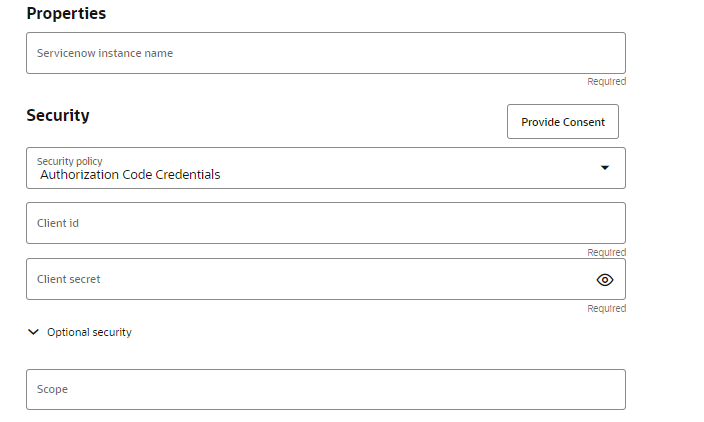
SAP S/4HANA Cloud Adapter – Client Certificate-Based Security Policy Support
A new security policy “Client Certificate-Based security policy” is introduced in the SAP S/4HANA Cloud Adapter.
This policy requires to upload the X.509 certificate in Oracle integration to establish the connection, and below are the steps to be followed to get the required certificate from SAP S/4 HANA
- Create a Certificate Authority (CA)-signed X.509 certificate. See S/4HANA Cloud APIs with Client Certificate Authentication.
- Configure SAP S/4HANA to enable this authentication and upload X.509 client certificate into Oracle Integration. For steps, see Prerequisites to Use the Client Certificate-Based Security Policy.
Connections page

REST Adapter – Amazon Selling Partner Security Policy
The REST Adapter enables you to easily integrate with the Amazon Selling Partner API through use of the Amazon Selling Partner security policy. The Amazon Selling Partner API (SP-API) is a REST-based API that helps Amazon selling partners programmatically access their data on orders, shipments, payments, and so on.
The SP-API can be used to increase selling efficiency, reduce labor requirements, and improve response time for customers, which helps selling partners grow their businesses.
Common use cases include the following:
- Uploading inventory and order data to Amazon.
- Obtaining financial information relevant to your business with Amazon.
- Retrieving/creating/updating shipping information and fulfillment information.
- Getting matching product information available on Amazon.
- Requesting various order reports.
- Retrieving information about a seller account, such as the marketplaces in which sellers participate.
Connections page
